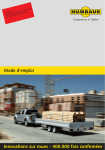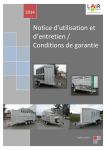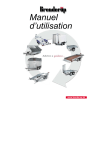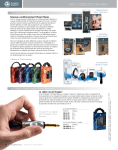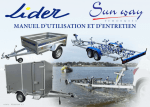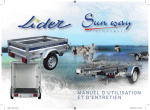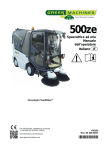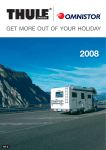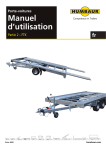Download Innovation on wheels- standing test of time Operating Instructions
Transcript
Operating Instructions ! tion! Atten d the ser n s. e se, s ack to u a e l P b card vice Operating Instructions Print errors and technical changes reserved! As of April 2006 Page Innovation on wheels- standing test of time Operating Instructions Congratulations Congratulations on your purchase of a HUMBAUR trailer; we are sure you will enjoy it a lot. We prepared this booklet to enable you to obtain maximum use and longevity for your trailer. Please read this booklet carefully through at least once and take special note of the technical details. Before they go into serial production, our products undergo the most stringent testing and during production are subject to frequent quality control checks. To maintain the quality and function of your trailer, we recommend only using original replacement parts. The buyer loses all rights of claim when the product is altered through use of other than original parts. We reserve the right to make technical and visual changes. Ordering of spare parts To expedite a correct spare parts order, please state type, model and chassis number of the trailer and also the make of the axles, brakes and coupling. Simply complete the following form from the details given on the trailer identification plate in case this information is required. Print errors and technical changes reserved! As of April 2006 Page Operating Instructions Contens Service and Warranty Conditions 1. Safety 1.1 Symbols 1.2. Proper Use 1.3 Safety-conscious operation 1.4 Organizational Measures 1.5 Maintenance and Repair 1.6 Safety during maintenance and assembly works 1.7 Mounting works on the chassis Page 5 - 6 2. Signage Page 8 3. Operation 3.1 Controls before driving 3.2 Coupling of the trailer 3.3 Disconnecting the trailer Page 9 Page 9 Page 9 4. Loading 4.1 Nose weight 4.2 Loading and unloading 4.3 Load 4.4 Securing of loads Page 10 Page 10 Page 11 Page 11 5. Operation of the units 5.1 Hand brake 5.2 Overrun brake 5.3 Axles 5.4 Tyres 5.5 Changing of a wheel 5.6 Spare wheel Page 12 Page 12 Page 12 Page 13 Page 13 Page 14 6. Brakes 6.1 General 6.2 Readjustment of ALKO wheel brakes 6.3 Readjustment of BPW wheel brakes 6.4 Brake pads 6.5 Security notes for brake systems Page 14 Page 14 Page 15 Page 15 Page 15 7. Electrical system 7.1 Accessories reversing light 7.2 Connector assignment 7-pin 7.3 Connector assignment 13-pin 8. Accessories 8.1 Soft cover on frame 8.2 Wood-aluminium cover 8.3 Telescopic prop stands 8.4 Aluminium loading skids Print errors and technical changes reserved! As of April 2006 Page Page 7 Page 7 Page 7 Page 8 Page 8 Page 8 Page 8 Page 16 Page 16 Page 16 Page 17 Page 17 Page 18 Page 18 Operating Instructions Contens 9. Support and maintenance 9.1 Galvanized parts 9.2 Wood side 9.3 Soft covers 9.4 Aluminium Page 19 Page 19 Page 19 Page 20 10. Lubrication plan 10.1 Overrun system 10.2 Bell crank lever 10.3 Live ring with fifth wheel trailer 10.4 Drawbar bolt for V-drawbar with fifth wheel trailer 10.5 Joints, compensation scales, Bowden cables 10.6 Ball-head coupling Page 20 Page 20 Page 20 Page 20 Page 20 Page 20 11. General 11.1 Driving 11.2 Braking behaviour 11.3 Use in winter and rain 11.4 Speed limit 11.5 Tyres Page 21 Page 21 Page 21 Page 22 Page 22 Inspection rules Page 23 Inspection – Service intervals Page 24 -26 For box vans, equipped with a refrigeration unit and possibly with a generator, the original operating instructions of the individual manufacturers accompany the vehicle documents. They must be complied with as regards use, maintenance and support of the units. Trailer Manufacturer HUMBAUR GmbH Mercedesring 1 86368 Gersthofen Germany Print errors and technical changes reserved! As of April 2006 Page Operating Instructions Service and Warranty Conditions From the initial day of purchase on, the Humbaur GmbH warrants the new Humbaur trailer for a period of two years when it is properly used and when the maintenance and inspection provisions are complied with. This warranty applies to the territory of the Federal Republic of Germany; moreover, this warranty does not affect the legal claims from the warranty law. The warranty includes: Replacement, or at the manufacturer’s discretion, repair of the construction or material defect and provided that the trailer was used for its intended purpose and within its defined limits. Any repair or replacement carried out under the stated conditions does not extend the warranty period. Conditions: Servicing in accordance with the instructions contained in this booklet must have been carried out. For repair works a use of original replacement parts is compulsory. Any repair must be carried out by an accredited Humbaur agent. For warranty claims, defects mustn’t arise from: - Non-compliance with the instructions contained in this booklet. - Use of the trailer for other than its intended purpose or from the user’s inexperience. - Arbitrary changes of the trailer and/or attach ments, which are not authorized by Humbaur GmbH, are not covered by this warranty. might have bleaching effects. Despite the most varied finishing and processing types, wood remains a natural material and is thus subject to a natural, climate-dependent dilatation and/or shrinking which might result in twisting. Natural wood grains and unevenness are typical for a natural material and can manifest themselves on the surface. For wood components a production tolerance in the thickness of +/- 1.5mm is defined. Deviations within this range cannot be objected to. Moreover, the polyester components are not absolutely colourfast; here too, there might be deviations due to UV or climatic influences. Stress cracks in the surface (capillary cracks), due to the production processes can not be avoided. These capillary cracks do not influence the stability and/or use of the trailer. Also rubber mats are subject to a certain, production-conditioned shrinking process, so that thickness tolerances of +/- 1mm must be accepted. Moreover, since rubber parts age in general as a result of UV-influences, there might also be crack formations or bleaching effects on the surface. In general, trailers are not isolated, therefore temperature variations might lead to formations of condensation water in the saddle chambers under the soft cover and aluminium or polyester covers. In this case ventilate sufficiently to avoid a formation of mould. Moreover, trailers are not absolutely water-proof. Water entries on the doors, lids and windows are possible despite using rubber seals and the most diligent workmanship. No defects are: Each trailer is a handicraft product. Despite the greatest diligence, small and superficial scratches might occur during assembly, which do not interfere with the proper use. The used wood is either coated with plastic or phenol resin. UV-radiation and climatic influences Print errors and technical changes reserved! As of April 2006 Page Operating Instructions Service and Warranty Conditions The warranty expires: The warranty does not cover: If the operating, maintenance and inspection instructions are not complied with, - Costs for regular trailer maintenance In the event of technical alterations of the trailer, In the event of arbitrary extensions or attachments, not authorized by Humbaur, When the trailer is overloaded or not used properly, When other than original Humbaur replacement parts are used, - Costs, attributable to normal wear and tear or problems caused through lack of trailer usage - Defects, arising from an improper treatment of the trailer - Defects, arising from a use of other than original Humbaur replacement parts - Repairs not carried out by an authorized Humbaur agent. When the safety information on the trailer is not complied with, When the servicing intervals, also for components mounted by Humbaur such as axle, brake, overrun system, hydraulic units etc. are not complied with, In the event of a inappropriate surface treatment of the materials used, In the event of a continued use of the trailer even if defects are known and notified and a further use has been forbidden by the manufacturer until completion of the repair works, In the event of a further use of the trailer when defects are known, which makes a repair impossible and/or more extensive or only possible with considerably more expenditure and when the use of the is reduced as a result of the continued use. Print errors and technical changes reserved! As of April 2006 Page Operating Instructions 1. Safety 1.1. Symbols Symbol “Operational Safety” Indicated every time, when there is a danger to life or health. It is particularly important to comply with those instructions. Next to the safety and accident prevention regulations, indicated in this booklet, the locally applicable provisions of the road traffic regulations, the road traffic licensing regulations and the accident prevention regulation for vehicles must be complied with. ! Attention Symbol “Attention” Indicated every time, when an improper operation might lead to damages of the vehicle. Symbol “Maintenance” Added to all maintenance provisions, ensuring a smooth and trouble-free use of the vehicle. 1.2. Proper Use The vehicle may only be operated according to the provisions in the operating instructions. It may only be used when it is technically in a sound condition. It may only be used by experienced users, who have read and understood these operating instructions. Prior to each start the trailer must be checked for road and operational safety. Moreover, the trailer must be authorized for a use on public roads and insured according to the provisions of the road traffic regulations. Working methods, restricting the safety of the trailer must strictly be omitted. All walls and locks must be closed and secured while driving. The trailer may only be used for its intended purpose. The safety and road traffic regulations of the countries concerned apply to the use of the trailer. 1.3. Safety-conscious use Read these operating instructions carefully before using the trailer. Always be aware of the safety and risks. Inform your interlocutor on failures and defects of the trailer. Do not use the vehicle until the failures and defects are remedied for. Comply with the allowed axle loads, nose weights and gross weights. Always adapt the driving mode to the road and weather conditions – respect climatic influences such as side winds, etc. Not allowed is: Excess of the allowable gross weight (see technical specifications, type plate) Transport of persons. ! ! Print errors and technical changes reserved! As of April 2006 Page Operating Instructions 1.4. Organizational measures Ensure that these operating instructions are always available. Ensure that only experienced drivers use the vehicle. Check at regular intervals whether the vehicle is used safely and risk consciously. Keep these operating instructions carefully and hand them out to the buyer in the event of a resale of the trailer. 1.5. Maintenance and repair Maintenance and repair works shall only be carried by authorized agents. Only original Humbaur replacement parts shall be used for repair. Additional extensions or alterations of the trailer are only allowed when authorized by the producer. Other provisions that must be complied with: Safety and accident prevention regulations, country specific provisions, rules and guidelines. 1.6. Safety during maintenance and assembly works ! Changes, alterations and processes, influencing the safety of the trailer and its operators are forbidden. Only Original-Humbaur-replacement parts may be used for maintenance works. The mounting of wheels requires sufficient knowledge and appropriate mounting tools. Mounting works may only be executed by trained personnel. 1.7. Mounting works on the chassis ! No additional holes may be drilled and no existing holes on the chassis may be bored up. In the event of welding or sanding works close to plastic lines and hydraulic tubes, the necessary protective measures (covering, disassembly) must be taken. 2. Signage All information and identification plates attached to the vehicle must always be clearly readable. Damaged and illegible plates must be replaced. Identification plate: The identification plate contains allowed axle loads, overall weight, type designation and chassis number. The chassis number is punched in the chassis Information plate nose weight: maximum allowed nose weight Minimum nose weight 4% of the trailer load, more than 25 kg not required. Control the allowed nose weight of the towing Retighten the wheel nut information plate after driving 50 km. Print errors and technical changes reserved! As of April 2006 Page Operating Instructions 3. Operation Prior to using the trailer, the operating instructions must be read and understood by the operator. For technical questions, please refer to your specialized Humbaur workshops. Before driving check the vehicle for road safety 3.1 Controls before driving a) Correct air pressure in the tyres b) Check lighting system for damages and operability c) Even distribution and safety of the load d) Complete locking of the draw bar 3.2 Coupling of the trailer The trailer is connected to the towing vehicle by means of the ball-head coupling. 3.2.1 3.2.2 3.2.3 3.2.4 3.2.5 3.2.6 ! Release safety catch (c) by squeezing against the locking grip (b) pull upwards and forwards (coupling opened). Bring the open coupling over the ball-head tow bar, push down on the locking grip to mate The coupling will close with a light downwards pressure. The electrical system is connected by plugging the trailer’s plug into the towing vehicle’s socket. Before driving, check to ensure the lighting is functioning correctly. On braked trailers connect the safety cable for the emergency disconnect brake (see diagram below, pos.1). braked execution unbraked execution 1 Attention On trailers with jockey wheels turn the jockey wheel fully upwards and/or on models with jockey wheel and clamp, push the jockey wheel in the clamp fully upwards. In doing so ensure that the jockey wheel will not foul the brake connection rod. Remove possible wheel chocks and disengage the parking brake. Driving with engaged brakes results in brake and tyre damages and dangerous driving behaviour of the trailer. 3.3. Disconnecting the trailer Before disconnecting the trailer protect it by means of the hand brake and/or wheel chocks against unintended rolling away. 3.3.1 Turn the jockey wheel downwards until the trailer in the ball-headed coupling is relieved. Print errors and technical changes reserved! As of April 2006 Page Operating Instructions 3.3.2 Remove the electrical plug and insert it into the holder provided. 3.3.3 On braked trailers, remove the emergency brake cable 3.3.4 Through release of the safety catch and simultaneous lifting of the locking grip, separate the trailer coupling from the vehicle tow bar. Be aware of possible load shifting during this operation. 3.3.5 When disconnecting the trailer on steep roads remember that the trailer runs away in unbraked condition. Thus, you must protect unbraked trailers against unintended rolling away with brake blocks under the wheels - original Humbaur wheel chocks would suit perfectly for this purpose. With braked trailers engage the hand brake. When parking the trailer on public roads and within city limits and at night, secure the trailer with reflecting parking tables. Anti-theft device A trailer is easily stolen. Therefore we recommend the purchase of an original Humbaur coupling lock and/or a locking shoe to prevent the ball-head coupling from opening, an effective anti-theft device. 4. Loading When loading the trailer do not excess the allowable gross weight. Ensure an even loading complying with the allowable nose weight. 4.1 Nose weight 4.1.1 4.1.2 4.1.3 4.1.4 ! ! The nose weight must amount to at least 4 % of the gross weight of the trailer, more than 25 kg are not necessary. A slightly higher nose weight in compliance with the maximum allowed nose weight of the trailer and/or the towing vehicle is generally an advantage. The indications can be found in the respective vehicle documents. Since single-axle trailers are designed such that the centre of gravity is slightly in front of the axle, ensure that the trailer is loaded evenly. In case of doubts, the load of the trailer can be slightly higher in the front area. Overloading the trailer in the rear area can have negative effects on the nose weight (nose weight too low) and thus also on the driving behaviour – skidding danger!! The nose weight can be easily controlled by means of a scale. Place the scale directly under the coupling head. Use a bar or a log wood, which is placed under the coupling head on the scale and cut it such that the trailer is placed horizontally. A wooden plate placed as support on the scale, distributes the pressure on the scale evenly 4.2 Loading and unloading 4.2.1 For the loading and unloading the trailer must be coupled to a towing vehicle. 4.2.2 The loading and unloading of single-axle trailers without towing vehicle is only possible with prop-stands (accessories) since the trailer can easily tilt backwards during loading - Risk of injury! 4.4.3 Moreover, the trailer must be protected against unintended rolling away. ! Print errors and technical changes reserved! As of April 2006 Page 10 Operating Instructions Push the pro-stands downwards by disengaging the toggle screw (fig. pos.1) until they stand firmly on the ground. 1 Firmly re-tighten the screws. After use reset the prop-stands back into the transport position and secure them. Attention Don’t forget to bring the prop-stands back in the transport position to avoid considerable damages to the pro-stands and/or the trailer when driving away. 4.3 Load 4.3.1 Always ensure an even and positive (never only on one side or unfavourable) distribution of the load on the platform. 4.3.1 Load, protruding the sides, is not considered as complying with the intended purpose and any damage resulting therefrom is not covered by the producer’s liability. Wrongly loaded Correctly loaded Wrongly loaded ! Weight too much in front, trailer’s nose weight too high, bad steering capability and too much stress on the towing vehicle’s axle Weight correctly distributed and lashed to the trailer ! Weight too far in the rear, almost no more nose weight – high risk of skidding, bad brake function 4.4 Securing of loads 4.4.1 4.4.2 4.4.3 4.4.4 4.4.5 4.4.6 4.4.7 4.4.8 The load must always comply with the traffic regulations and with the VDI-stan- dard. Lash it tightly and safely to the vehicle and/or secure it by other means, which are appropriate for the respective load. All sides and catches must be kept closed and secured while driving. To secure the load, Humbaur trailers are by standard and depending on the model equipped with ring eyes, bolted and riveted constructions or other clamping possibilities below the platform. . On trailers with soft cover on frame the load must be secured correspondingly, since the soft cover on frame does not sufficiently secure the load. Likewise, the load inside box vans must be secured. Humbaur offers many options for this purpose such as tie rails, tie rails with bars and slotted tie rails. We recommend the Humbaur lashing tracks (Pos.2) with ratch to secure the load (accessories). Other appropriate tools are tie rings (Pos.1, support loads of up to 360 dAN/kg) or flap rings (accessories). 2 Before transporting heavy loads with specific load pressure points, please check with your Humbaur agent or with the factory, to clarify if the platform is suitable for such a special case. 1 Print errors and technical changes reserved! As of April 2006 Page 11 Operating Instructions 5. Operation of the units 5.1. Hand brake (only for braked models) 3 5.1.1 Hand brake without gas spring – spring brake (3) On these models the hand brake lever must only be pulled over the dead-point; the gas spring will clamp the brake and keep it clamped. To disconnect the brake, clamp it a little more and keep the knob in the lever pushed. Push the hand brake lever downwards to the front over the dead centre. Attention 5.1.2 On these models, the hand brake lever must be pulled into the vertical position. This clamps the spring cylinder on the brake connection rod. ! 1 If the hand brake without gas spring is not brought into the vertical position, the trailer is secured against rolling forth, but not against rolling back.. Please note, that even when the hand brake is fully engaged, the trailer will still roll back about 25 cm before the brake takes full effect. 5.2 Overrun brake 5.2.1 5.2.2 . All braked trailers are equipped with a Rückmatik brake system and except the lubrication of the overrun piston and the bell crank lever do not require additional maintenance. Lubricate the overrun piston every 5,000 km or once per year with multi-purpose grease (see lubrication plan point 10.1). 5.3 Axles 5.3.1 All Humbaur trailers are equipped with maintenance-free rubber torsion beam axles with the exception of some of the horse trailer models. Possible repairs of the axle may only be carried out by the producer. 5.3.2 Welding works on the axle tubes are forbidden, since this might lead to damages of the rubber springs, resulting in a loss of the damping and suspension properties, which will have negative effects on driving behaviour and safety. 5.3.3 After 2,000 km or 6 months check the axial play of the boss bearing. To do this, jack up the trailer, disconnect the brake lines and ensure the wheels turn smoothly on the axle without resistance. 1 5.3.4 If necessary, adjust the axial play of the wheel bearing - Remove the decoration and the wheel-hub cap. - Remove the split-pin from the castellated wheel nut. - Tighten the nut while spinning the wheel until a resistance is felt. If possible use a torque wrench (50 Nm). - Turn the castellated nut 1/12 of a turn (30°, see diagram 1) then turn back to the next pin alignment position. Axial play to 0.05 mm is acceptable. ! Print errors and technical changes reserved! As of April 2006 Page 12 Operating Instructions Attention Overtightening will cause bearing damage - Check grease for quantity and condition, top-off or renew, if necessary - Grease type for wheel bearings: Multi-purpose grease DIN 51825 KTA3K - Replace wheel hub caps 5.4 Tyres 5.4.1 5.4.2 Air pressure Different types of tyres require different tyre pressures for optimal performance and minimum wear. Air pressure table – Check the air pressure regularly Tyre size Air pressure in bar Load capacity/ wheel in kg Tyre size Air pressure in bar Load capacity/ wheel in kg 145R10 2,7 347 155/70R13 2,7 426 155R13 2,7 481 155/80R13 2,7 481 175/70R13 2,7 523 175/80R14 2,7 616 175/65R14 2,7 523 185/60R14 2,7 523 185/60R14 2,7 525 195/50R13C 6,25 900 185/65R14 2,7 583 185/70R14 2,7 616 195/60R14 2,7 583 195/65R14 2,7 638 195/60R15 2,7 677 195/65R15 2,7 677 205/60R15 2,7 677 185R14C 4,5 853 155/70R12XCX 6,5 900 5.00 -10C 2,5 360 18.5 x 8.5-8 3,4 425 195/50B10 6,0 825 195/55R10 5,3 825 20.5 x 8.0-10 6,2 695 225/55B12 5,4 900 155/70R12C 6,25 800 185/60R14 2,7 525 5.4.2 5.4.3 5.4.4 ! If the trailer will not be used for a long period, raise it on blocks (smaller trailers may be stood on the end). This prevents static load, which can cause deformati on of the tyre. Only experienced personnel may repair tyres. According to § 36 of the road traffic licensing regulations, tyres must have a minimum profile depth of at least 1.6 mm at each point of the tyre. Wear markings, distributed evenly around the perimeter of the tyre inform you on the condition of your tyres. Replace worn tyres immediately. 5.5 Changing of a wheel 5.5.1 Secure the trailer against rolling away. 5.5.2 It is forbidden to stay under the lifted vehicle without additional and appropriate support. 5.5.3 Turn the wheel nuts cross-wise with a torque wrench to the prescribed torque ! Print errors and technical changes reserved! As of April 2006 Page 13 Operating Instructions Wrench width 17 bzw. 19 mm 19 mm 24 mm Thread M 12 x 1,5 M 14 x 1,5 M 18 x 1,5 Tightening torque 80 - 90 Nm 110 - 120 Nm 270 - 280 Nm Attention 5.6 Spare wheel After driving the trailer for 50 km, check the wheel nuts of the changed wheel with a torque wrench and tighten, if necessary 5.6.1 5.6.2 Humbaur offers for each trailer model the appropriate spare wheel as accessory. It can be mounted to the trailer with the help of a bracket (not available for all models) and/or transported loosely. Spare wheels, which are older than 2 years are no longer suited for a permanent use as running wheel and must be dismantled after their use but they can still be used as spare wheel. 6. Brakes 6.1 General All braked Humbaur trailers are equipped with a 2- and/or 4-wheel overrun brake system with automatic reverse and do not require additional maintenance. Any maintenance and adjustment works of the brake system shall only be carried out by experienced personnel. After every 5,000 kilometres or every 12 months adjust the brake pads to compensate for wear by readjusting the brake shoes. When readjusting the brakes, find out which type of axles is integrated into your trailer. Humbaur uses axles of the producers BPW and Alko. You can control the type of axles on the cover of the boss, on which you find the logo of the respective producer 6.2 Readjustment of the Alko wheel brakes 6.2.1 Jack-up the trailer and disconnect the brake lines. 6.2.2 Turn the adjustment screw, while turning the wheel with a screw driver until the brake drum can no longer be turned. 6.2.3 Then, turn back the set screw until the brake drum turns free in a forward direction. 6.2.4 Check for equal braking action of all wheel brakes of a trailer and, if necessary, re-adjust as described above. 6.2.5 Adjustments may only be made using the adjustment screws of the wheel brake, never on the turn buckle or Bowden rod yoke. Print errors and technical changes reserved! As of April 2006 Page 14 Operating Instructions 6.3 Readjustment of the BPW wheel brakes 6.3.1 6.3.2 6.3.3 6.3.4 6.3.5 6.3.6 6.3.7 6.3.8 6.3.9 Jack-up the trailer and disconnect the brake lines. Lock the pivot cams of the wheel brake with the 4mm-tool- pin (diagram, pos. A) through the pitch bore from outside. Adjust the adjustment screws (pos. C) on the wheel brakes, depending on the model, with a screwdriver (Pos. B) and/or a wrench (pos. D) until the brake drum does no longer turn in the running direction. Centre the brake shoes by actuating the parking brake a couple of times. Model 1: turn back the adjustment bolt by approximately 1 turn until no more braking action can be felt when turning the brake drum in the running direction. Model 2: turn back the adjustment bolt by approximately 2-5 tooth turns until no more braking action can be felt when turning the brake drum in the running direction. Check the position of the brake compensation valves with pulled parking brake. Rectangular position to the brake con nection rod = equal play of the wheel brakes; re-adjust the brake adjustment if necessary. To control it, slightly pull the parking brake and check for equal braking torque on the left and right sides of the wheels. Remove the locking device (pin) from the pivot cams. Adjust the transmission rods so that they are free from play and force. All brake compensation valves must be in rectangular position to the brake connection rod. Tighten all lock nuts of the brake transmission. Model 1 Model2 Model 1 Model 2 6.3 Brake pads Every 5,000 km and/or every 12 months adjust the brake pads to compensate for wear. The wear of brake pads depends on the driving behaviour. Driving carefully and considerately avoids tyre and brake pads wear. ! Once the brake pads are down to about 1 mm thickness, replace them. In addition to that, replace slackened or overstretched brake wire springs, in which the coils are no longer positioned properly on top of each other or which are damaged. The thickness of the brake pads can be checked by a visual inspection on the aperture (picture above Pos. 5). Brake pads may only be replaced by experienced technicians. 6.4 Security notes for brake systems To avoid braking problems, test the proper functioning of the trailer brake in connection with the towing vehicle regularly by test brake actions. These test brake actions must be made especially then, when you change the towing vehicle. Make regular visual inspections of the braking system by observing the following criteria: Attention 6.4.1 6.4.2 Guidances, Bowden wires and Bowden rod yokes mustn’t be damaged or corroded. Dust sleeves and seals mustn’t be damaged externally. Print errors and technical changes reserved! As of April 2006 Page 15 Operating Instructions 6.4.3 6.4.4 6.4.5 6.4.5 Joints on Bowden rod yokes and rods must be duly secured and smooth running. Moreover, those components mustn’t be rejected. Bowden cables must be guided properly and without visible damages. Control brake pads and adhere to required minimum thickness. When changing the brake pads always control the wheel bearings for wear and damages 7. Electric lighting system All Humbaur trailers are equipped as standard with safety lighting and 7 pin plug. This safety lighting contains indicators, rear lights, brake light, fog light and the licence plate light. If the towing vehicle is equipped with a 13 pole socket the electrical connection to the trailer can be made with an adapter (accessories). Prior to driving check the functioning of the lighting system! Damaged lights can be replaced after unscrewing the light cover. Remember to use the prescribed power (Watt) for the individual lights. 7.1 Accessories reversing light Humbaur offers a reversing light as accessory. If the trailer is ordered 7.2 Connector assignment 7 pin Indicator left Fog light Ground Indicator right Rear light right Brake lights Rear light left 7.3 Connector assignment 13 pin with reversing, a 13 pin socket 1 2 3 4 5 6 7 Indicator left Fog light Ground for contact 1-8 Indicator right Rear light right Brake lights Rear light left Reversing light Continuous current (continuous plus) Charger cable Free Free Ground for contact 9-12 L 54g 31 R 58R 54 58L yellow blue white green brown red black 1 2 3 4 5 6 7 8 yellow blue white green brown red black grey 9 10 11 12 13 Both ground cables mustn’t be electroconductively connected to the trailer side. Print errors and technical changes reserved! As of April 2006 Page 16 Operating Instructions 8. Accessories 8.1 Soft-covers on frame To increase the load volume, and to protect sensitive materials, Humbaur offers soft covers on frame in various heights for the trailers. Also when transporting goods with soft cover on frame the load must be properly secured, the cover frame itself is not sufficient. When driving with the soft cover in bad weather conditions, such as strong wind, gusts, strong side winds etc. you must be very careful, since the trailer can topple down in its unloaded condition. Under extreme wind situations such as hurricane gusts etc. stop driving with the coupled trailer. ! Humbaur GmbH shall not be liable for accidents resulting from a maladjusted speed under the aforementioned conditions. When driving with the soft cover on frame on, completely close the soft cover before driving and secure it with the provided securing means. Driving without the soft cover but only with the frame is forbidden. Please, remember that the soft cover protection does not protect the parked trailer against theft. 8.2 Wood-aluminium cover ! To transport sensitive loads such as camping equipment, etc. safely a lockable aluminium-wood cover can be ordered as accessory for trailers with a platform length of up to 3 m. Close the wood-aluminium cover before driving and lock it with the key to prevent it from opening automatically. To open the cover, unlock the lock – turning of the lock unlocks the cover. A gas spring facilitates the lifting of the cover and keeps it in its upper end position. When the gas springs are untight or worn, the cover will no longer be maintained in its upper position and will close automatically – Risk of injury. Therefore, replace broken gas springs immediately. Attention It is strictly forbidden to stay inside the trailer with the wood-aluminium cover closed and when transporting animals – Risk of suffocation!! Print errors and technical changes reserved! As of April 2006 Page 17 Operating Instructions 8.3 Telescopic prop-stands ! To provide the trailers with the necessary standing safety when loading and/or boarding them, Humbaur offers telescopic prop-stands, which are flanged to the frame. 8.3.1. Transport position For the transport position mount the support on the connection tubes parallel to the frame and secure with the corresponding plug. 8.3.2 Attention Working position After removing the plug, pivot the supports downwards by 90° and secure them again with the plug. Use the provided crank (2) to turn the supports downwards until they are away from the ground by about 4-6 cm when the trailer is unloaded – when the ground is soft use an 2 appropriate and sufficient support (board, etc..). These 4-6 cm correspond approximately to the spring travel of the axle; if the supports are turned fully downwards they must support the full load when driving and can be damaged. 8.3.3 Maintenance telescopic prop-stands Lubricate the telescopic prop-stands regularly after use and/or once per year on the nipple (picture above - 3) on top at the crank case. 1 3 8.4 Aluminium loading skids To load the HT-models of the 2000 series, Humbaur offers Aluminium loading skids. For the transport the skids are stored under the platform. 8.4.1 Correct positioning of the skids to the trailer: - Use the delivered square wrench to open the cover of the skid insert on the rear protective device. - Pull out both skids from the insert. - The rear wall is opened. - The clips (1), which are attached with a wing screw to the skid, are screwed on as explained in the scheme at right and inserted in the groove of the skids. - The skids are applied to the platform (3) as shown in the scheme and in doing so the clip must be plugged between the wall (2) and the loading area. - The distance between the skids must be adjusted correctly to the track of the vehicle to be loaded. Print errors and technical changes reserved! As of April 2006 Page 18 1 2 3 Operating Instructions 8.4.2 ! Boarding of the trailer: - To board the trailer it must be stabilized with telescope crank support on the rear (see 8.3). - The trailer must be coupled to the towing vehicle and secured against rolling away. - The driving speed should be correspondingly slow, avoid jerky steering movements to prevent that the skids 1 displace. - Place the vehicle in compliance with the load distribution on the trailer and tie it. 2 Attention Slip hazard when it is wet or slippery or when the tyres or skids are dirty! 8.4.3 Load capacity, safety instructions, other - The skids, available from Humbaur as accessories provide a load capacity of 2300 kg each pair with an axle distance of 1.00 m to the vehicle to be loaded. - The Aluminium loading skids are suited for vehicle with tyres and rubber crawlers. -The skids are not suited for vehicle with steel crawlers. - In addition to that observe the safety instructions (picture above Pos. 1) on the skids ! 9. Support and maintenance 9.1 Galvanized parts Galvanised parts need time to oxidise before they offer an effective protection against rust. The galvanisation only realises its full potential when the metal becomes dull looking. Galvanisation can be attacked by acids and other chemicals. For these reasons the trailer should always be rinsed off with a pressure washer after use on salted roads or after transportation of fertilisers or other acidic substances. In these cases rinsing off should always be carried out whether the parts are freshly galvanised or already oxidised. We also recommend treating the galvanised parts occasionally with a commercial anticorrosion product. 9.2 Wood sides Humbaur trailers with wood sides are made of multiple laminated waterproof plywood with a plastic coating and are maintenance-free. By and by, the wood walls can become a little dull through weather influences. 9.3 Soft covers The soft cover constructions are made from a high quality, almost maintenance free material. Possible stains can be easily and fastly rinsed-off with a pressure washer. To clean the soft covers and maintain the material, we recommend the original Humbaur aluminium and soft cover cleaner. Print errors and technical changes reserved! As of April 2006 Page 19 Operating Instructions 9.4 Aluminium All aluminium components are made from extruded aluminium and are thus almost maintenance-free and can be cleaned with a pressure washer. To remove strong staining and maintain the brilliance of the aluminium, we recommend here as well the Humbaur Aluminium and soft cover cleaner. 10. Lubrication plan Use the standard multi-purpose grease according to DIN 51825 KTA 3K for all lubrication points 10.1 Overrun system (braked trailers) 1 The lubrication points (1) of the overrun system are identical for tube drawbars und V-drawbars. Grease both nipples every 5,000 km and/or once per year. 10.2 Bell crank lever parking brake (Humbaur) There is a nipple (2) at the bottom side at the bell crank lever of the parking brake. Grease the nipple every 5,000 km and/or once per year. 10.3 Live ring on fifth wheel trailers Three nipples are distributed around the complete perimeter of the live ring of fifth wheel trailers. Grease them every 5,000 km and/or once per year. 10.4 Drawbar bolt for V-drawbar on fifth wheel trailers Both nipples (4) of the drawbar support on the centre pivot plate must also be greased every 5,000 km, and/or once per year. . 10.5 Joints, compensation scales, Bowden cables on the brake Grease these components on the points, marked with the arrows and/or lubricate them and control them for smooth running. 10.6 Ball head coupling Clean the ball head coupling regularly. Lubricate the ball adapter, the joints and bearing points regularly on the position marked with the symbol „oil can“ and grease them on the locations marked with a „grease press“. Check the coupling for smooth running and wear. Print errors and technical changes reserved! As of April 2006 Page 20 2 3 4 Operating Instructions 11. General 11.1 Driving 11.1.1. The faster the speed, the worse the driving stability of rigs; therefore don’t drive with the maximum speed under unfavourable street, weather and wind conditions. Use all trailers carefully on inclines. 11.1.2 When the roads are slippery remember that the driving stability and the braking action are restricted through a reduced adhesion of the tyres. 11.1.3 When driving backwards with the trailer, the driver must ensure that he doesn’t risk the safety of other road users and shall be instructed by an expert, if necessary. 11.1.4 When driving with long trailers and with fifth wheel trailers remember the turn radius and the tailing after in turns. Remember, moreover, not to turn-in too much when switching to avoid a collision of the trailer with the towing vehicle. It is forbidden to stay between the towing vehicle and the trailer. 11.2 Braking behaviour 11.2.1 Since a trailer rig provides another braking behaviour than an individual passenger car, untrained drivers should make a couple of careful brake tests on appropriate terrain. 11.2.2 Please, remember as well that the braking distance of a trailer rig is longer than the one of an individual towing vehicle and that the braking distance is greater when the towing vehicle is loaded. 11.2.3 The ABS-system does not control the overrun system in the trailer; therefore you must brake early enough! Brake trailers with overrun systems first smoothly to avoid a blocking of the wheels of the trailer and then slow down speedily. 11.3 Use in winter and rain 11.3.1 If, in particular trailers with soft cover or box vans are parked outside remember that after snow and rainfall, the snow and rain can collect on the roof which might freeze in winter time. Before driving remove water, ice and snow from the roof to avoid any accident danger for the following cars and passengers. 11.3.2 Parked box vans should not be positioned horizontally, so that the rain water can drain and does not stay on the platform. Print errors and technical changes reserved! As of April 2006 Page 21 Operating Instructions 11.4 Speed limit 11.4.1 When driving the trailers comply with the local speed limits. When driving abroad comply with the local speed limits for trailer rigs 11.4.2 11.5 Tyres 11.5.1 For all Humbaur trailers new, high-quality tyres are used that are in general designed for a speed of 80 km/h. The production date on the tyre must conform to the production date of the trailer. When the tyres are stored correctly a tyre of up to four years from the production date can be accounted as new tyre and is fully covered by the warranty of the tyre producer. Comply with the local minimum profile depths. 11.5.2 11.5.3 If the trailer is not used very often, remember that tyres age faster through weather influences such as direct sunlight. Therefore, control them regularly. Print errors and technical changes reserved! As of April 2006 Page 22 Operating Instructions Delivery inspection Vehicle component Control To be carried out Braking system Braking action Inspect, adjust, if necessary Tyres Air pressure Inspect, adjust, if necessary Lighting Lights Inspect, replace, if necessary 1. Inspection, not later than after 1,000 km after delivery Vehicle component Control To be carried out Braking system Braking action Inspect, adjust, if necessary Tyres Air pressure Inspect, adjust, if necessary Build-up Bolted connections Lighting Inspect, retighten, if necessary Control, repair, if necessary Wheel bearing Play Grease Inspect, adjust, if necessary Inspect, replace, if necessary Other inspections, no later than every 5,000 km and/or at the latest 1/2 year after the last inspection Vehicle component Control To be carried out Braking system Brake pads Inspect, replace, if necessary Braking mechanism Control, repair, if necessary Sliding points braking mechanism Grease Overrun system Grease Play Inspect, adjust, if necessary Brake Adjust Wheel bearing Bearing Inspect, replace, if necessary Seals Inspect, replace, if necessary Grease Inspect, replace, if necessary Play Adjust Axles Damages Visual control, repair, if necessary Fixing Control, repair, if necessary Tyres Damages Obsolescence Profile True running Air pressure Visual control, replace, if necessary Inspect, replace, if necessary Measure depth, at least 1.6 mm Inspect, balance, if necessary Inspect, adjust, if necessary Drawbar/ overrun system Bolted connections Inspect, replace, if necessary Build-up Bolted connections Damages/ corrosion Inspect, retighten, if necessary Inspect, correct, if necessary Electrical equipment Connectors, cables, lights Reverse lights, reverse lamps Connectors, cables, lights Connectors, cables, lights Print errors and technical changes reserved! As of April 2006 Page 23 Operating Instructions Delivery service 1.000 km - Inspektion Date 5.000 km - Inspektion Stamp Specialized workshop Stamp Specialized workshop Stamp Specialized workshop Signature Not later than 1/2 year after delivery Signature Not later than 1/2 year after last inspection 10.000 km - Inspektion 15.000 km - Inspektion 20.000 km - Inspektion Stamp Specialized workshop Stamp Specialized workshop Stamp Specialized workshop Signature Not later than 1/2 year after last inspection Signature Not later than 1/2 year after delivery Signature Not later than 1/2 year after last inspection 25.000 km - Inspektion 30.000 km - Inspektion 35.000 km - Inspektion Stamp Specialized workshop Stamp Specialized workshop Stamp Specialized workshop Signature Not later than 1/2 year after last inspection Signature Not later than 1/2 year after delivery Signature Not later than 1/2 year after last inspection Date Signature Print errors and technical changes reserved! As of April 2006 Page 24 Operating Instructions 40.000 km - Inspektion 45.000 km - Inspektion 50.000 km - Inspektion Stamp Specialized workshop Stamp Specialized workshop Stamp Specialized workshop Signature Not later than 1/2 year after last inspection Signature Not later than 1/2 year after last inspection Signature Not later than 1/2 year after last inspection 55.000 km - Inspektion 60.000 km - Inspektion 65.000 km - Inspektion Stamp Specialized workshop Stamp Specialized workshop Stamp Specialized workshop Signature Not later than 1/2 year after last inspection Signature Not later than 1/2 year after delivery Signature Not later than 1/2 year after last inspection 70.000 km - Inspektion 75.000 km - Inspektion 80.000 km - Inspektion Stamp Specialized workshop Stamp Specialized workshop Stamp Specialized workshop Signature Not later than 1/2 year after last inspection Signature Not later than 1/2 year after delivery Signature Not later than 1/2 year after last inspection Print errors and technical changes reserved! As of April 2006 Page 25 Operating Instructions 85.000 km - Inspektion 90.000 km - Inspektion 95.000 km - Inspektion Stamp Specialized workshop Stamp Specialized workshop Stamp Specialized workshop Signature Not later than 1/2 year after last inspection Signature Not later than 1/2 year after last inspection Signature Not later than 1/2 year after last inspection 100.000 km - Inspektion 105.000 km - Inspektion 110.000 km - Inspektion Stamp Specialized workshop Stamp Specialized workshop Stamp Specialized workshop Signature Not later than 1/2 year after last inspection Signature Not later than 1/2 year after delivery Signature Not later than 1/2 year after last inspection 115.000 km - Inspektion 120.000 km - Inspektion 125.000 km - Inspektion Stamp Specialized workshop Stamp Specialized workshop Stamp Specialized workshop Signature Not later than 1/2 year after last inspection Signature Not later than 1/2 year after delivery Signature Not later than 1/2 year after last inspection Print errors and technical changes reserved! As of April 2006 Page 26 Operating Instructions Print errors and technical changes reserved! As of April 2006 Page 27 Vehicle data – Service card Please, compare the entries in the registration document with those on your vehicle (e.g.: chassis number, wheels, possibly equipment) and inform us immediately on any inconsistencies. We can not warrant later error notices as to the entered data and their possible consequences (penalties, etc.). Please, enter your vehicle data here Trailer Identification number: Type: Allowed gross weight: Ball head coupling Manufacturer: Type: Test symbol: Axle Manufacturer: Test symbol: Overrun system Manufacturer: Type: Test symbol: Wheel brake Manufacturer: Type: Version: Inspection number: Zugdeichsel Manufacturer: Type Test symbol: Tyres Manufacturer: Size: License plate: Speed index: Service card Please, send it back immediately to the Humbaur GmbH, Gersthofen Company: ______________________________________ Acceptance declaration: Name: _________________________________________ I received the Humbaur trailer with the entered chassis Post code/ Town: _________________________________ number in a perfect condition and without visible or E-Mail:_________________________________________ technical defects. I was instructed in the use of the trailer or waived to it at my own request. The equipment of the trailer complies with the purchase agreement.. Trailer type: : ___________________________ ________ Please, send us the service card back immediately after delivery of the trailer, it must be fully completed and provided with the stamp of the dealer and signature. You thus Day of first homologation: __________________________ secure your guarantee and warranty claims. Chassis number: ________________________________ Place: : ________________________________________ Use: private Your Humbaur dealer commercial Date:____ Signature Customer _____________ Postage paid by receiver ANTWORT HUMBAUR GmbH Abt. Kundendienst Mercedesring 1 D-86368 Gersthofen






























